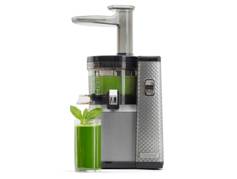Guide to Juicing
Cold Press Juicing Benefits


The cold press juicer has an auger that creates a slower pressing action that opens the food’s cell membranes and releases its deep-seated nutrients and enzymes.
There are many different types of juice available for purchase at your local grocery store, health food store or juice bar. But even though they are all called juice, that is where the similarity ends.
Most mass-produced juice sold in grocery stores is “pasteurized”, meaning that it went through a high-heat pasteurization process where the juice is heated up to the boiling point in order to kill pathogens and extend shelf life. It is thought that through this heating process some of the health benefits of the juice may also be destroyed.
Centrifugal or rotary juicing is common in most juice bars and also many home juicing appliances. One of the telltale signs of a centrifugal juicer is the sound that they make. With blades spinning at speeds up to 16,000 RPM’s, these very noisy juicers shred and pulverize fruits and vegetables. This high-speed spinning action separates the liquid from the fruits and vegetables similar to how your washing machine works when it is on the spin cycle. This high speed extraction method generates heat and accelerates the oxidation of the juice, degrading the juice’s color and nutritional benefits. Oxidation is what happens when you leave apple slices out on the counter and exposed to air. This same thing happens with high speed juicing and the oxidation can destroy some of the vitamins and minerals.
The cold-pressing of fruits and vegetables is a method of juice extraction that has been around for thousands of years. This is how the Roman’s extracted oil from their olives. During cold-pressing the juice is extracted by slowly exerting pressure on the fruit or vegetables. This pressure squeezes out the juice, leaving only the pulp.
The Nama cold press juicer features an auger that quietly spins at 43 RPM’s to slowly press fruit and vegetables against the 6,612 micro-perforations in the juice strainer. This action opens up the food’s cell membranes, releasing its deep-seated liquid loaded with nutrients and enzymes. The cold-pressing also maximizes the extraction of the liquid trapped inside, vitamins, minerals and phytonutrients, resulting in rich colors and pure flavor of the juice. This slow extraction method ensures that it does not disrupt the cellular structure of the fruits and vegetables, minimizing oxidation and heat, preserving the precious enzymes and nutrients as close as possible to their natural form.
Cold press juices made in your Nama juicer can be a very beneficial addition to your daily routine. Some of the ways that we can benefit from cold press juice include:
- Increased consumption of micronutrients and vitamins
- Cold pressed juice is easy for our bodies to digest
- Easy way to add more servings of fruit and vegetables into our diets
- Support for our immune systems
- Increased overall hydration of our bodies
- Delicious flavors rich in phyto-nutrients especially when we juice bright, deep colored fruit and vegetables
- Feeding our gut with soluble fiber and healthy enzymes
Cold press juice made with a Nama juicer might take a little more time each day, but the time spent is well worth the effort. The resulting cold press juice is a delicious and nutritious way to flood our bodies each day with vitamins, hydration, minerals and immune boosting phytonutrients.
The cold press juicer has an auger that creates a slower pressing action that opens the food’s cell membranes and releases its deep-seated nutrients and enzymes.
- Choosing a selection results in a full page refresh.
- Press the space key then arrow keys to make a selection.



